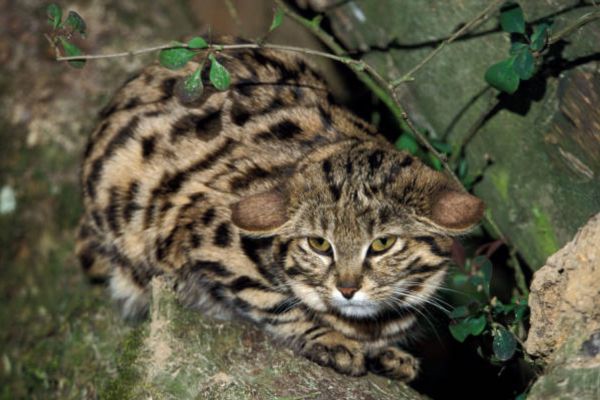Amid the shadows of the desert, where life seems an insurmountable challenge, a fascinating creature emerges, the Black-footed Cat, known scientifically as Felis nigripes. This species is endowed with adaptabilities that defy human understanding. In this article, we delve into the existence of this little feline, a true master of the arid lands of Southern Africa.
While many view the desert as a hostile environment devoid of life, this cat shows that with the right adaptations, it is not only possible to survive, but to thrive. Join us on this journey of discovery, where we reveal the hidden secrets behind this impressive animal’s abilities, behaviors and ecological interactions, and how it weaves its story into the intricate tapestry of the desert ecosystem.

Uncovering the Arid: Mysteries and Challenges of Southern Africa
The arid environments of Southern Africa, which encompass vast expanses of savannas, deserts and semi-deserts, are characterized by high temperatures during the day and drastic drops in temperature at night. The landscape is often dotted with thorny, drought-adapted vegetation, with a limited presence of perennial bodies of water. Rains, when they occur, are generally unpredictable and spaced out, making water availability a constant challenge. This combination of factors creates a habitat where survival depends on the ability to adapt to extreme conditions and seasonal variability.
Despite these adversities, the arid habitat of Southern Africa is home to a remarkable biodiversity, with species that have developed unique mechanisms to cope with water scarcity, extreme temperatures and limited food availability. Animals, in particular, exhibit behaviors and physical adaptations that allow them to make the most of available resources, even in hard times. In this challenging scenario, the Black-footed Cat stands out as an emblematic example of resilience and adaptability.
Hydration the Desert Way: The Black-footed Cat’s Aquatic Secrets
Felis nigripes, like many animals adapted to arid environments, has developed remarkable strategies to deal with water scarcity. Firstly, your diet plays a crucial role in this process. By feeding mainly on small mammals, birds and insects, this feline obtains a significant amount of water directly from the tissues of its prey. This reduces the need to seek out water sources, a task that could expose it to predators or adverse environmental conditions. Additionally, his highly efficient renal system allows him to concentrate his urine, minimizing water loss and helping him maintain hydration even when drinking water is scarce.
Additionally, the Black-footed Cat’s behavior is a key to its water conservation strategy. By being predominantly nocturnal, it avoids the hottest hours of the day, when dehydration would be faster. This not only saves energy but also reduces the need for sweating to cool the body. Their reclusive habits and tendency to take refuge in holes or under rocks during the day also help maintain a cooler, moister environment around their bodies, further conserving their valuable hydration.
Desert Nights: How Does the Black-footed Cat Defy the Heat?
When the moon emerges and stars dot the desert sky, the Black-footed Cat awakens, transforming the tranquil arid landscape into his nighttime playground. This twilight and nocturnal behavior is not just a stylistic preference; it is a vital survival strategy. By choosing to operate under the cloak of twilight and night, this small feline avoids the scorching heat of the day, when the relentless sun can turn the desert floor into a fiery frying pan. This timing means less exposure to extreme temperatures, resulting in less need to sweat and, consequently, conserving precious body fluids.
But this feline’s ingenuity doesn’t stop there. Your body is a marvel of thermoregulation. The light color of its coat reflects solar radiation, helping to prevent overheating during the rare times it ventures out during the day. Additionally, its ability to control blood flow close to the surface of the skin allows it to effectively dissipate heat when needed and conserve heat during cold desert nights. In an environment where every drop of water and every spark of energy counts, the Black-footed Cat exemplifies the art of adaptation.
Desert Hunts: An Adaptive Diet
Amid arid expanses, where food may seem scarce to many, the Black-footed Cat reveals a masterful ability to find and capture prey. Its menu, adapted to desert conditions, is mainly composed of small mammals, such as rodents, but also extends to birds, insects and even reptiles. These, in addition to serving as vital sources of nutrients, also provide the cat with much-needed hydration as an added bonus to its hunting efforts.
Hunting in such an unforgiving environment requires strategy and cunning. The Black-footed Cat employs an ambush technique, using the cover of night and low vegetation or holes in the ground to sneak up on its prey. He is patient, often waiting in silence until prey is within reach. In some cases, it even digs into the rough soil to extract rodents from their burrows. This determination, combined with his agility and quick reflexes, makes him one of the most efficient hunters in his world, ensuring that even in the arid environment, he finds the sustenance he needs to thrive!
Morphological Magic: The Adaptations of Felis Nigripes to the Arid
- As it ventures across the desolate and arid landscapes of Southern Africa, the Black-footed Cat brings with it an arsenal of physical adaptations that are a testament of evolution. Firstly, its paws, which give the species its name, have thick pads that protect the cat from hot, rocky soils while also allowing it to move silently while hunting.
- Its compact body and short stature make it easy to move through undergrowth and holes, offering shelter and ambush advantages. Its large, luminous eyes are optimized for night vision, allowing it to detect prey and predators in low-light conditions. Additionally, their enhanced auditory system is crucial for locating prey hidden underground or in vegetation.
- And finally, its coat, light in color with dark spots, not only helps with thermoregulation, but also gives it camouflage, blending perfectly with the hues of the desert. Every morphological aspect of this feline is a testament to its incredible adaptation to the environment in which it lives.
The Art of Reproduction in the Desert
- In the heart of the arid environment, the Black-footed Cat’s life cycle persists with admirable resilience. Reproduction of this species is a delicate dance, often synchronized with periods when resources are a little more abundant, such as after occasional rains that bring brief but significant relief to the desert. After a gestation period of around two months, the female chooses a protected location, often using abandoned burrows or natural cavities, to give birth to her litter. These shelters not only offer protection from predators, but also ensure a relatively stable and cool environment for the newborns.
- As the cubs grow, the mother faces the ongoing challenge of feeding them in often inhospitable terrain. Her nocturnal nature becomes even more pronounced during this period, as she ventures out at night to hunt, returning to shelter at dawn with food for her young. The cubs learn quickly, and at just five months old, they begin to accompany their mother on hunting expeditions, learning vital skills for survival in the desert. The combination of instinct, learning and meticulous maternal care ensures that the next generation of Black-footed Cats is prepared to face the challenges of the arid habitat they call home.
Desert Web: The Ecological Connections of the Black-footed Cat
In every ecosystem, each species plays a critical role in the web of life, and the Black-footed Cat is no exception. Within the arid environment, this feline operates as a population controller, mainly of small mammals and insects. By preventing these populations from becoming excessively numerous, the black-footed feral cat helps maintain an ecological balance, which in turn influences vegetation and the overall health of the ecosystem.
On the other hand, this feline is also potential prey for larger predators, such as nocturnal birds of prey or even other larger carnivores. This predator-prey interaction, although brutal, is an essential component of ecological dynamics. In addition to direct food relationships, the cat also interacts with other species in subtle ways. For example, it often appropriates holes abandoned by other animals, establishing a relationship of commensalism. In essence, through its direct and indirect interactions with other species, the Black-footed Cat plays a vital role in maintaining the health and resilience of the arid ecosystem to which it belongs.
The Black-footed Cat’s journey across the arid wastes of Southern Africa is a celebration of nature’s resilience, adaptability and ingenuity. Every facet of its existence, from its physical adaptabilities to its behavioral strategies, highlights the magic of evolution and life’s incredible ability to find a way, even in the most adverse conditions. The Black-footed Cat is not just a testament to the tenacity of desert life; he is a reminder that, in the midst of the toughest challenges, the most fascinating stories of overcoming emerge. Through the study of this remarkable feline, we are reminded of the interconnectedness of all things and the precious tapestry of life that stretches to the most inhospitable corners of our planet.

